There are many legendary locations around the world that people have sought after for hundreds, or even thousands, of years. One of the most famous of these locations is Camelot, Arthur’s grand city, often presented as the capital of his kingdom. There are numerous theories as to where this grand city really was, if it even existed at all. Here, we will examine some of the most famous and most convincing theories.
Caerleon
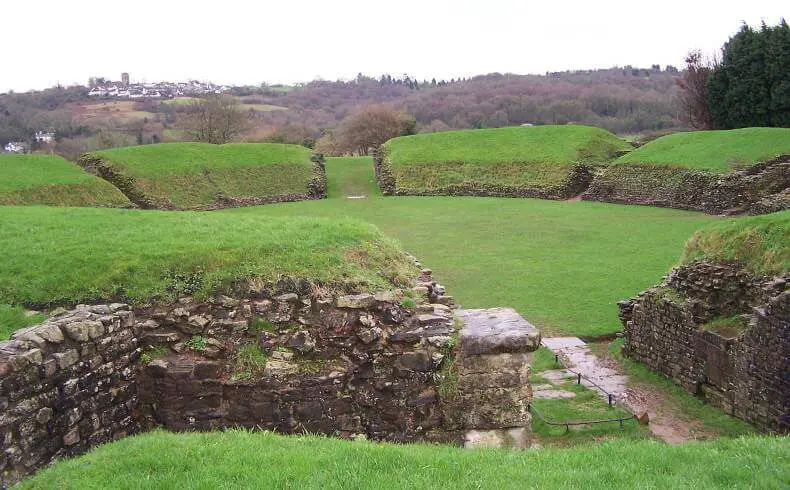
One of the most popular candidates for Camelot is Caerleon-upon-Usk, the Roman town in south east Wales. It is easy to see why, because there are grand stone remains still to be seen here, especially of the large amphitheatre which some people link to the Round Table at Camelot. This town was also associated with Arthur in early records, supporting the conclusion that this was Camelot. Additionally, William Caxton stated, in the preface to Le Morte d’Arthur, that Camelot’s stone ruins could still be seen in Wales, which matches Caerleon.
However, one fatal flaw in this theory is a detail found in the earliest reference to Camelot, which is in a work of Chretien de Troyes called Lancelot, the Knight of the Cart, written in the 12th century. This reference makes it clear that Caerleon and Camelot were two separate places, by stating that Arthur rode from the former location to the latter one. Therefore, according to the earliest piece of information we have about the city, Camelot was not Caerleon.
Camelon
This next theory is rooted in the idea that Arthur was a northern ruler. There is some evidence for this, such as the allies and associates that Arthur is given in the legends. Furthermore, even the early Welsh Triads place one of Arthur’s courts in the north. Therefore, the idea that Camelot was also in the north of Britain is not too unlikely.
The particular location proposed by some proponents of a northern Arthur is Camelon, a settlement near Falkirk in Scotland. Apart from the obvious similarity between the names of the two sites, another reason to connect this to Arthur’s city of Camelot is the fact that nearby was a structure which was known as ‘furnum Arthur‘ (or ‘Arthur’s Oven’) at least as early as the 13th century.
However, there are several flaws in this theory. The most significant is that it does not conform to Chretien’s claim that Camelot was within a day’s journey of Caerleon in south east Wales. However, perhaps this could be dismissed as a slight error of detail on Chretien’s part. Another flaw in the theory is the fact that the original name of Camelon may have actually been Carmure or Carmore, as argued in The Stirling Antiquary. If this is the case, then this settlement’s nominal similarity to ‘Camelot’ becomes unacceptably weak.
Camulodunum
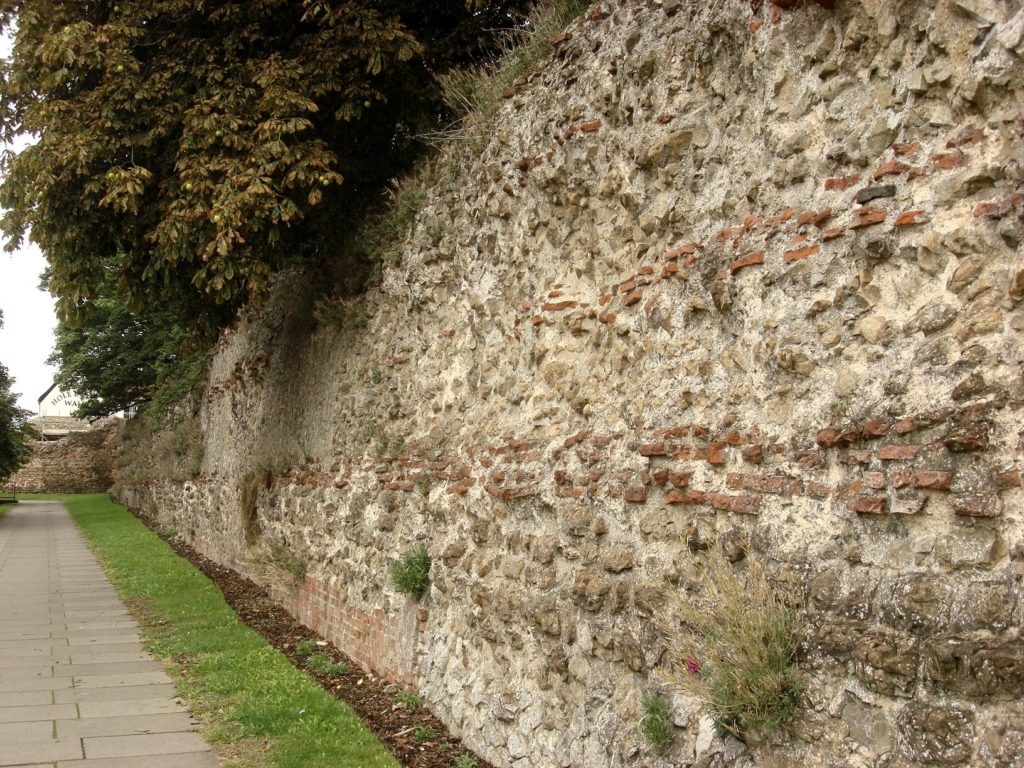 An alternative candidate proposed by some who favour a northern Arthur is the Slack Roman fort near Huddersfield in West Yorkshire. While those who favour the Camelon theory generally identify Arthur as Artuir mac Aedan, those who favour this Yorkshire location generally present Arthur as Arthwys ap Mar, a far more plausible candidate.
An alternative candidate proposed by some who favour a northern Arthur is the Slack Roman fort near Huddersfield in West Yorkshire. While those who favour the Camelon theory generally identify Arthur as Artuir mac Aedan, those who favour this Yorkshire location generally present Arthur as Arthwys ap Mar, a far more plausible candidate.
However, does the location itself stand up to scrutiny? Well, the reason for identifying the Roman fort at Slack with Camelot is due to the probability that this was known in Roman times as Camulodunum. It can immediately be seen that there is a similarity between the Arthurian place name and the Roman place name. It is not hard to imagine that the latter, over quite a few centuries, could have evolved into the former. And given its location within the right area for a northern Arthur such as Arthwys ap Mar, it is not hard to see the appeal in this theory.
Unfortunately, there are several key problems with this theory. Firstly, there is the same problem that was encountered by the Scottish Camelon theory – it does not match Chretien’s description of Camelot being less than one day’s journey from Caerleon. However, as with the above, this could conceivably be dismissed as a mistake on the part of Chretien. But William Caxton also supported such a detail, by stating that Camelot was in Wales. But he was writing in the 15th century, so perhaps this too could be dismissed on the basis of being very late.
Even with those two counter-points dismissed, there are still some significant problems with the idea that the Roman fort at Slack was Camelot. Firstly, it has been argued by non-Arthurian authorities that the name of this Roman fort was not actually ‘Camulodunum’, but ‘Cambodunum’. In this case, the nominal similarity between Camelot and this Roman fort falls to pieces.
A final piece of evidence against this identification is the fact that archaeological excavations have determined that this site was completely abandoned by the early fourth century at the very latest. It is therefore impossible for it to have been Arthur’s city of Camelot in the sixth century.
Cadbury Castle
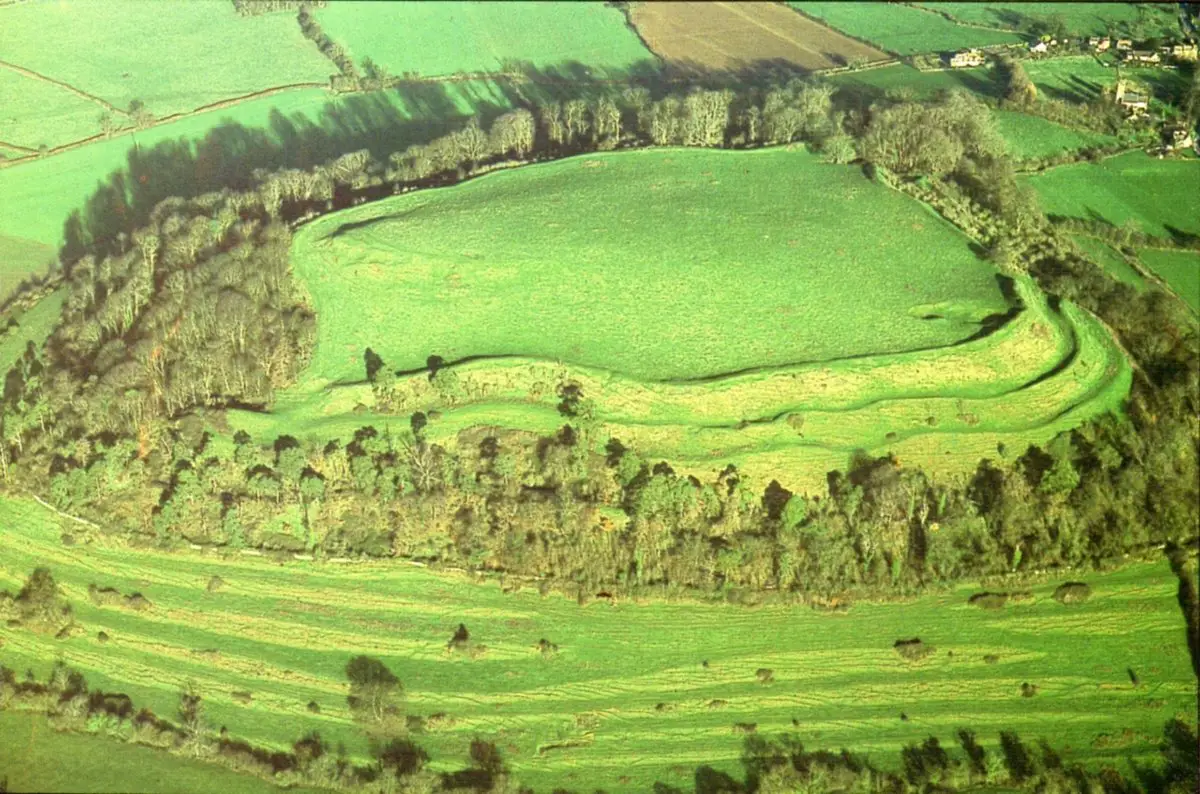
An extremely popular theory is that the hillfort known as Cadbury Castle was the real Camelot. This is the theory which has the greatest academic support, although such support is still minimal in an absolute sense (for most scholars consider Camelot to be fictional).
The initial piece of evidence which led to this theory is from the description of the place given by John Leland in the 16th century. He claimed that this place, Cadbury Castle, was formerly known as Camalet. This is so close to ‘Camelot’, which itself has many variant forms in the legends, that it can be considered essentially identical.
Archaeological investigations have discovered that this site was occupied from about 470 until about 580, which makes it a possible candidate for one of Arthur’s cities. Furthermore, the remains that have been discovered there have been noted for their incredible size for the era. It has been said that Cadbury Castle was twice the size of any other fortified settlement of the time. It had a ‘Grand Hall’, 20 meters by 10 meters. Mediterranean pottery revealed that it was involved in substantial trade links.
The fact that this site was evidently so incredibly significant for the period has led to the natural conclusion that this was the capital city of the king of that area. Being in Somerset, it was possibly within the realm of the kingdom of Dumnonia (though it is also possible that it was slightly outside the eastern border of that kingdom). If it was, then the possible connection to Arthur is strengthened, since the literary tradition gives him strong connections to Dumnonia.
In addition, local tradition connects several spots at Cadbury with the name ‘Arthur’. For example, there is Arthur’s Well, partway up the side of the hill. Most intriguingly, the uppermost part of the hill is known as ‘Arthur’s Palace’. This is very suggestive of Camelot.
It is very easy to see the appeal in this theory, and it is definitely the best one so far. It is in the general vicinity where Arthur was said to have been active, it was a very powerful and important fort and was thus highly likely to have been used by Arthur if he really was the king of that area, and the traditions and place names in this area support it being associated with him.
However, despite all this evidence, there is still some reason to doubt that this was the true site of Camelot. While we certainly accept that this could, possibly, have been one of his courts, we must recognise that he would likely have had many around the country. After all, the Dark Age kings did not have a permanent residence, but travelled from place after place throughout their kingdom. Thus, the fact that Cadbury was possibly one of Arthur’s courts does not necessarily mean that it was Camelot.
The earliest mention of the city places it within a day’s journey of Caerleon, while Cadbury is some 44 miles from that Roman town, as the crow flies. This is about two day’s journey on foot, but obviously this would be hastened by a boat voyage across the Severn. Therefore, while it was not strictly within one day’s journey of Caerleon, it was reasonably close, and the error may simply lie with Chretien’s description of events.
Nonetheless, William Caxton definitely believed that Camelot was in Wales. While we cannot be sure that his confidence was not misplaced, this statement does argue against Cadbury being Camelot, especially when viewed in conjunction with Chretien’s description.
So, while Cadbury remains a distinct possibility for the real Camelot, it is worth investigating several other locations that actually do fit with the information provided by Chretien and Caxton, to see if these might match the legendary Camelot any better.
Llanmelin
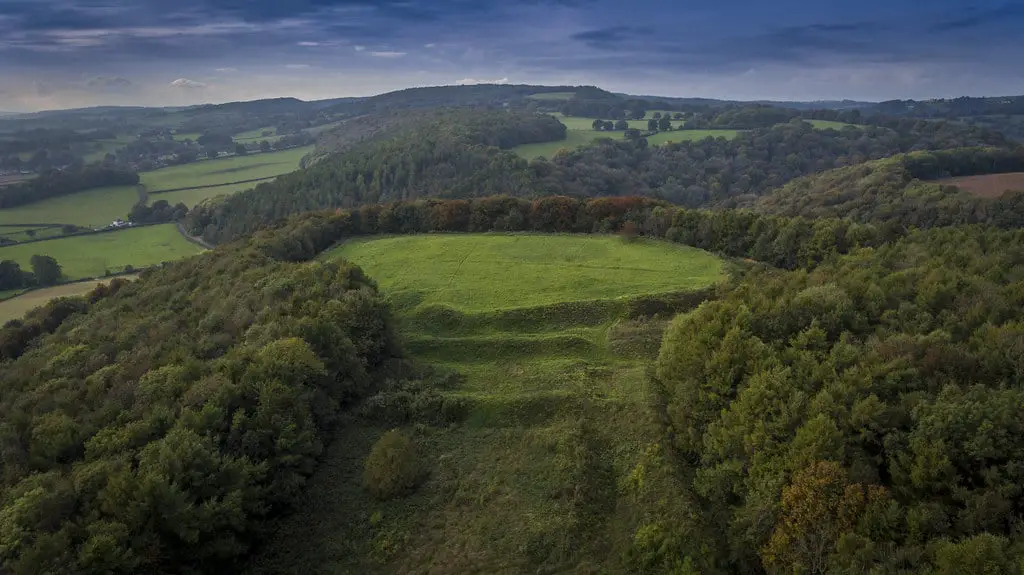
One site in south east Wales that has been put forward is Llanmelin, a hillfort just over a mile from the Roman town of Caerwent. This theory is primarily rooted in an analysis of the name ‘Camelot’, which concludes that it comes from the Welsh words ‘Caer’ and ‘Melyn’ or ‘Melin’. On the basis of Llanmelin evidently being associated with the word ‘Melin’, it is theorised that this fort was formerly known as ‘Caer Melin’, which then became corrupted into ‘Camelot’.
The appeal in this theory is that this site is located in south east Wales. Therefore, it conforms to the evidence from both Chretien and William Caxton. In addition, the supporters of this theory claim that this site also matches Arthur’s court of Gelliwig. It is known that a former name of Llanmelin was Llan-y-Gelli, which these theorists claim is evidence that it was Gelliwig.
The fact that this site has potential connections to both Camelot and Gelliwig reinforces the case for it being one of Arthur’s courts, so the logic goes. However, are these pieces of evidence really that valid?
First of all, let us consider the spelling of the name ‘Camelot’. In the earliest surviving mention of the city, in Chretien’s Lancelot, the Knight of the Cart, it is spelt ‘Camaalot’. In later records, there are a variety of different spellings used, and these include ‘Camehelot’, ‘Camahaloth’, ‘Camaelot’, ‘Kamaalot’, ‘Kamaaloth’, and other similar variations.
Notably, a huge number of these spellings (including the earliest) testify to there being an extra syllable in the middle of the word. It is simply by chance that ‘Camelot’, with only three syllables, became the form of the word that is most widely known today. In reality, it seems that the name of the location originally had four syllables, the word being best represented by ‘Camahalot’. This being the case, attributing the name to ‘Caer Melin’ does not seem very reasonable, especially in view of the unexplained transition from the final ‘n’ to a ‘t’.
Regarding the supposed evidence that Llanmelin was Gelliwig, it must be acknowledged that ‘Gelli’ is an extremely common element in Welsh place names. Therefore, the fact that this site was known as Llan-y-Gelli cannot really be taken as significant.
The final nail in the coffin for this theory is the fact that archaeological research had revealed that this hillfort ceased to be inhabited after either the first or second century C.E. Therefore, it absolutely could not have been one of Arthur’s courts.
Graig Llwyn
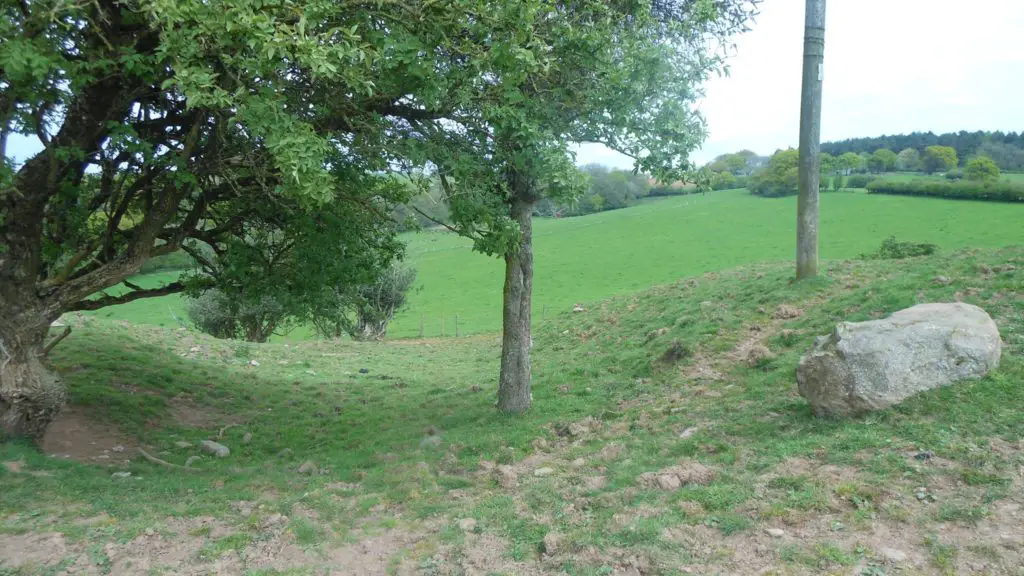
A more well-thought out theory is one that also places Camelot in south east Wales, and employs a very similar naming theory (deriving the name from ‘Caer Melyn’). This location is a hillfort at Craig Llwyn, near Cardiff. The theorists behind this explanation came to this conclusion partly on the basis of the fact that this hillfort is in roughly the centre of a perceived ring of forts, just as Caerleon, it seems, is in the centre of a neighbouring ring of forts. This, they argue, supports the conclusion that this was a very important fort, likely one of Arthur’s main courts.
Another piece of evidence is the fact that the name of the area in which the hillfort is located is ‘Cibbwr’, known by various different spellings over the centuries. This, according to the supporters of the theory, is derived from the Welsh element ‘cy’, which denotes a mutual action, and ‘bwrdd’, which means ‘table’. Thus, they believe that ‘Cibbwr’ signifies ‘mutually together at the table’, or ‘the mutual table’, or something to that effect. This is then felt to be a reference to the Round Table, at which Arthur and his knights were supposed to have sat together at Camelot.
This theory has some evidence to support it, but there are a number of problems. Firstly, let us consider the matter of the name. Unlike the previous location, this theory employs the Welsh word ‘melyn’ (meaning ‘yellow’) rather than ‘melin’ (meaning ‘mill’). Deriving the name ‘Camelot’ from ‘Caer Melyn’ is slightly more plausible than deriving it from ‘Caer Melin’, because, according to these theorists, this name came to be transformed by the influence of Latin, changing the ‘Melyn’ into ‘Mellitus’, a Latin word meaning ‘honeyed’ (honey having a yellow appearance). From this point, ‘Caer Mellitus’ then became shortened and corrupted into ‘Camelot’.
So this theory can, tenuously, explain the change from a final ‘n’ to a final ‘t’, unlike the previous theory. However, there is no direct proof that this hillfort was known by the name ‘Caer Melyn’. The basis for this conclusion is not that it was ever recorded as being connected to the element ‘melyn’, but that there are sulphur pits nearby, and presumably for that reason, there are several local place names that incorporate the word ‘yellow’ into them.
Therefore, while it is possible that this hillfort was once known as ‘Caer Melyn’, evidence that it actually was known by that name is very weak. The naming evidence is important, for without it, this could easily have been just another one of Arthur’s courts.
Furthermore, even if this hillfort did possess that name, the analysis in the previous section about the original spelling of ‘Camelot’ makes it very implausible that the two names could be connected.
In addition, the fort itself is very small. It is recognised on Coflein, a database of ancient and medieval monuments, as a ‘fortified enclosure’ rather than a ‘hillfort’. If it was occupied in Arthur’s time (it seems that dating evidence has been gathered concerning this site) then it could hardly have been more than a personal residence. It certainly could not have been the grand city of Camelot.
Caerwent
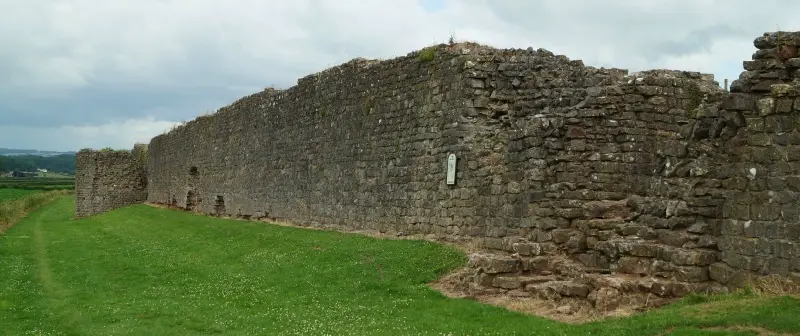
A much more likely location is the Roman town of Caerwent. Unlike the above-mentioned location, this was a grand settlement with impressive stone walls. It could easily be the place to which William Caxton was referring when he mentioned that the grand stone walls of Camelot were still visible in his day.
This Roman town was still in use in Arthur’s time, as archaeology and written records confirm. It was near Caerleon in south east Wales, so it fits the general area indicated by Chretien in the first mention of Camelot.
Therefore, we can see that this settlement, Caerwent, fits the general picture that the sources give about Camelot. However, a more specific detail is the fact that there is a church dedicated to Stephen in Caerwent, dating back even to Roman times. Similarly, there was said to have been a church of St Stephen in Camelot.
While there is no clear explanation about why Caerwent would have been referred to by the name ‘Camelot’, there is some evidence from the name of this settlement that it is the correct identification. In Le Morte d’Arthur, Malory tells us that Camelot was called, in English, Winchester.
So, how does this fit in to Caerwent bring Camelot? Well, the English translation of the former name is ‘Winchester’, on the basis that the Welsh ‘caer’ is equivalent to the English ‘chester’ (both meaning ‘fortified settlement’) and the elements ‘went’ and ‘win’ both come from the Latin ‘venta’. So ‘Caerwent’ and ‘Winchester’ are exact equivalents, one in Welsh and one in English.
Therefore, if Camelot was a prominent, large settlement within a day’s march of Caerleon, with surviving stone walls hundreds of years later, a church dedicated to Stephen inside, and a name which could be translated into English as ‘Winchester’, it is a virtual certainty that the Roman town of Caerwent is the place in question.


Interesting to read – I’m glad I got to see this. Reminds me about so many gaps in my own knowledge of this period.
Thank you, I’m glad you liked it and benefited from it!
What about the Tintagel Castle Theory? Would be great to hear your opinion on that theory.